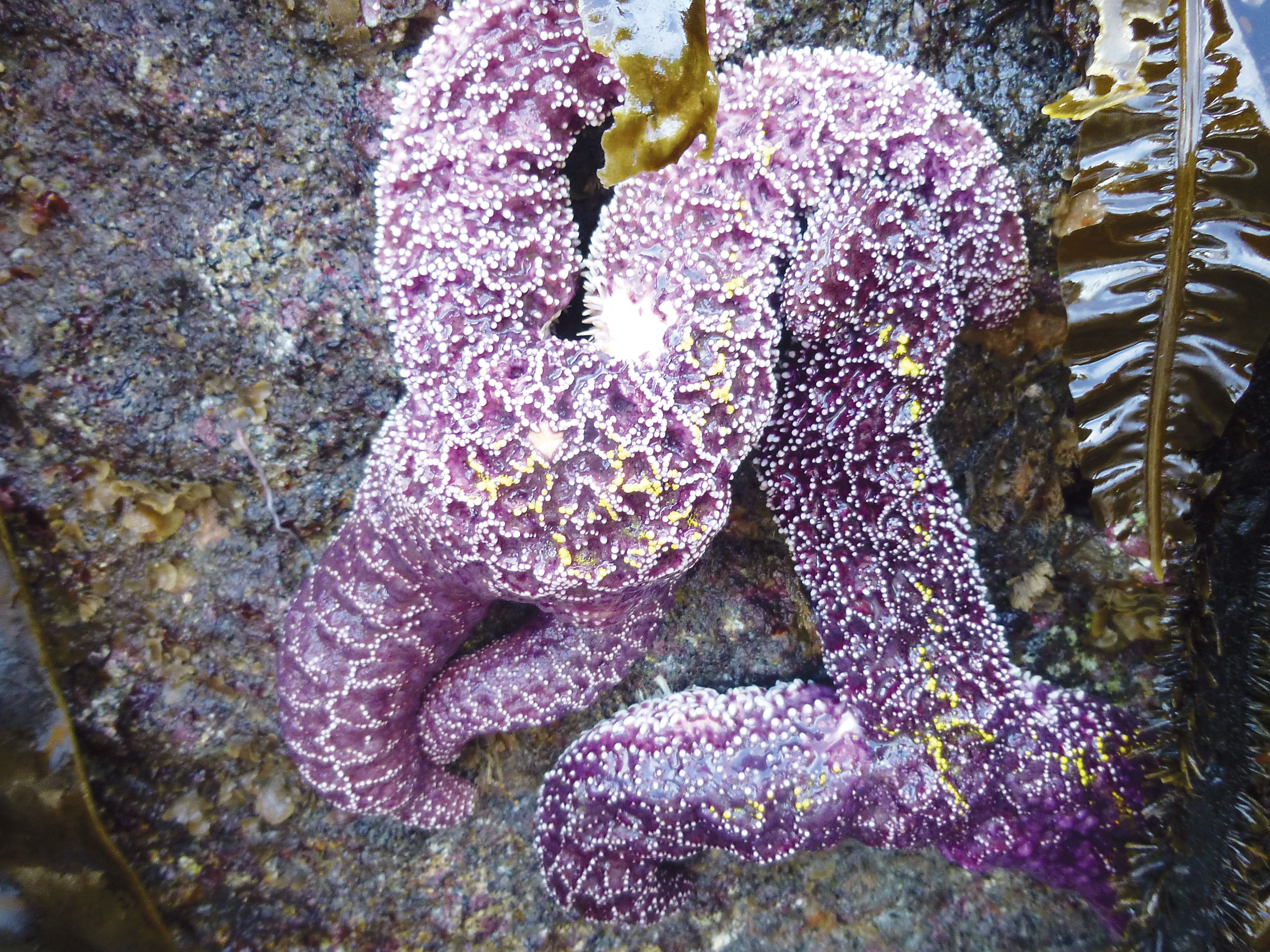The efforts of volunteers across the North Olympic Peninsula have been vital in recent months as scientists work to uncover the secrets of a mysterious affliction eating its way through sea star populations up and down the West Coast.
“Citizen scientists” have braved slippery rocks along the northern coasts of Clallam and Jefferson counties to seek signs of the disease, called sea star wasting syndrome, in the multi-armed creatures that live on the craggy shorelines.
“It’s been really, really helpful actually,” said Melissa Miner, a Bellingham-based researcher.
Miner is one of an army of scientists teaming up to learn more about the affliction that has killed millions of sea stars along the West Coast of North America since last June.
Volunteer surveys have been tracking affected sea star populations in Clallam County’s Freshwater Bay, east of Joyce, and at sites in Indian Island County Park, south of Port Townsend.
At its worst, the sickness turns healthy sea stars into piles of goo as white lesions first appear on their arms and eventually spread across their entire bodies, disintegrating their flesh.
The disease has been reported as far north as Alaska and as far south as Mexico.
Information gathered from both researcher and volunteer sea star surveys on the location and prevalence of affected animals has provided important data that is helping scientists piece together the puzzle of the affliction, Miner said.
The exact causes remains a mystery, Miner said, though researchers at universities across the nation, including Cornell University in New York and Western Washington University in Bellingham, are analyzing sea star flesh samples for bacteria or viruses.
“I think it’s kind of an unknown at this point, why it affects some areas and not others,” Miner said, adding that affected populations often form a patchwork across a given stretch of coastline.
Sea star wasting die-offs had been reported in the 1970s and 1990s, Miner said, with some correlation with periods of warmer-than-average ocean temperatures.
The sea star deaths seen in the last two years, however, are much more widespread and have happened over a shorter period of time, Miner said.
“[They have] also persisted through the winter, which we have never seen before, so it’s been kind of unusual that way,” Miner said.
Researchers noticed the first signs of the most recent wave of the illness in ochre sea stars a year ago this month off Star Fish point, north of the Kalaloch area of Olympic National Park.
“It is unusual for something like this to occur the way it did, that so many animals in different geographical locations were affected at the same time,” said Chrissy McLean, marine program coordinator for the Port Townsend Marine Science Center in Fort Worden State Park.
McLean leads the Indian Island surveys.
At the Indian Island site, McLean said 20 percent of sea stars observed in a May 16 survey showed signs of the disease, up from 5 percent seen during a February trip.
The affliction affects multiple species, McLean said, including the dark purple and orange examples of ochre sea stars — one of the most common species — and large sunflower stars.
Since December, McLean said 34 sea stars have died of the disease in the marine science center’s tanks, which have salt water continuously pumped into them from the waters around Port Townsend.
More surveys are planned in July and August so additional comparisons can be made, McLean said.
Potential volunteers can call 360-385-5582 to find out more.
Helle Andersen, a volunteer and contract educator for the Feiro Maine Life Center in Port Angeles, has organized a volunteer survey of rocky areas of Freshwater Bay in Clallam County every month since November.
After a June 15 survey, Andersen said 13 of 227 sea stars observed, or about 6 percent, showed signs of the disease.
That’s up from zero during the first survey in November and 4 percent during a January survey, Andersen said.
“Overall, that is still pretty low compared to what a lot of other people are reporting, so that’s great,” Andersen said.
The next Freshwater Bay survey is set for July 27, Andersen said.
Those interested in volunteering can call the Feiro Marine Life Center at 360-417-6254 for more information.
Miner works from Bellingham as a research associate with the University of Santa Cruz’s Multi-Agency Rocky Intertidal Network, a coalition of research groups collecting sea star survey data from hundreds of sites along the West Coast of North America.
Miner said she has worked with both the Feiro Marine Life Center and the Port Townsend Marine Science Center to train volunteers on how to collect data in sickened sea stars.
McLean and Andersen said information from the surveys they’ve led has been shared with the network.
“There’s been a lot of really great collaboration between all the different research organizations,” McLean said.
The network maintains a trove of information about the disease and an interactive map of sea star survey sites at its website at http://tinyurl.com/PDN-SeaStar.
There, members of the public can submit photos and report sightings of afflicted sea stars through an online form.
________
Reporter Jeremy Schwartz can be reached at 360-452-2345, ext. 5074, or at jschwartz@peninsuladailynews.com.

